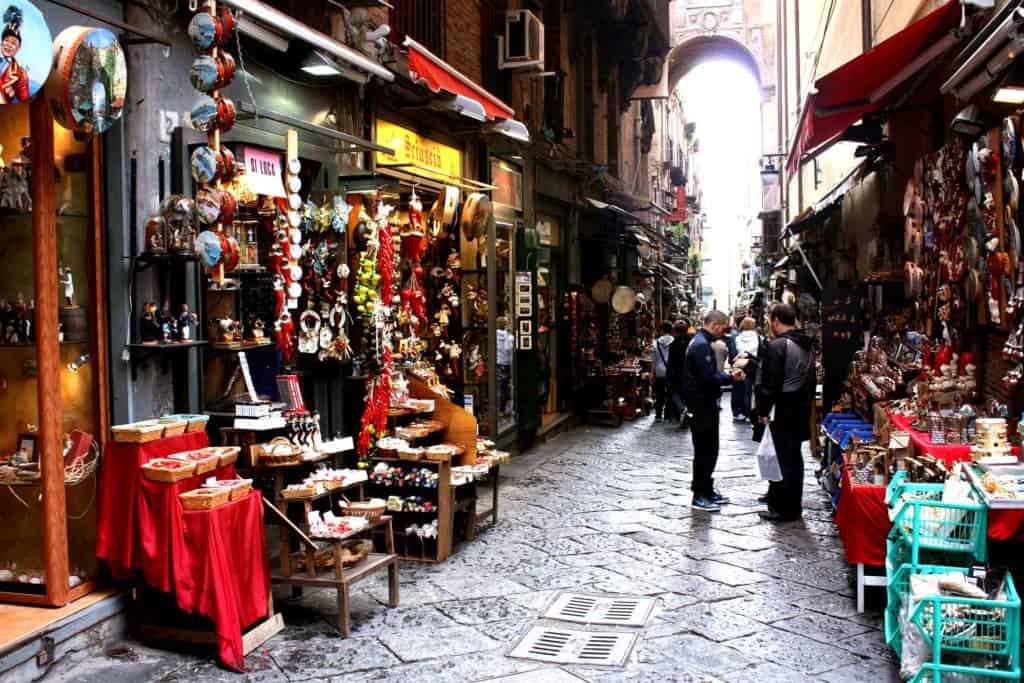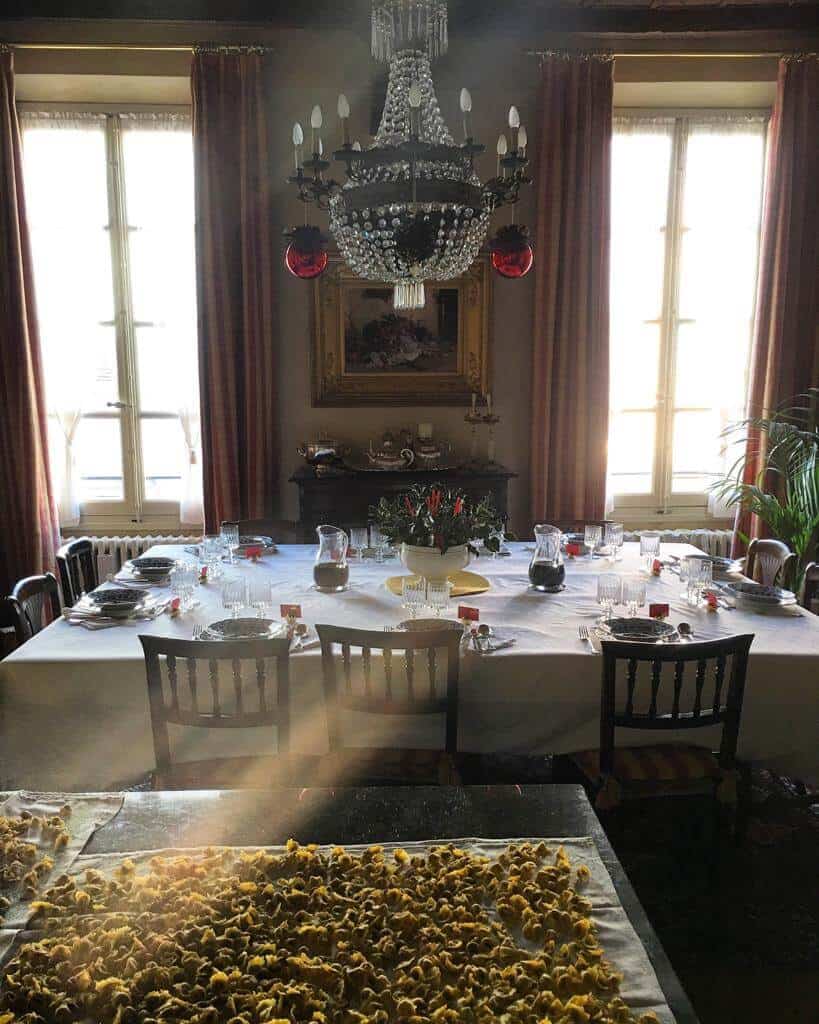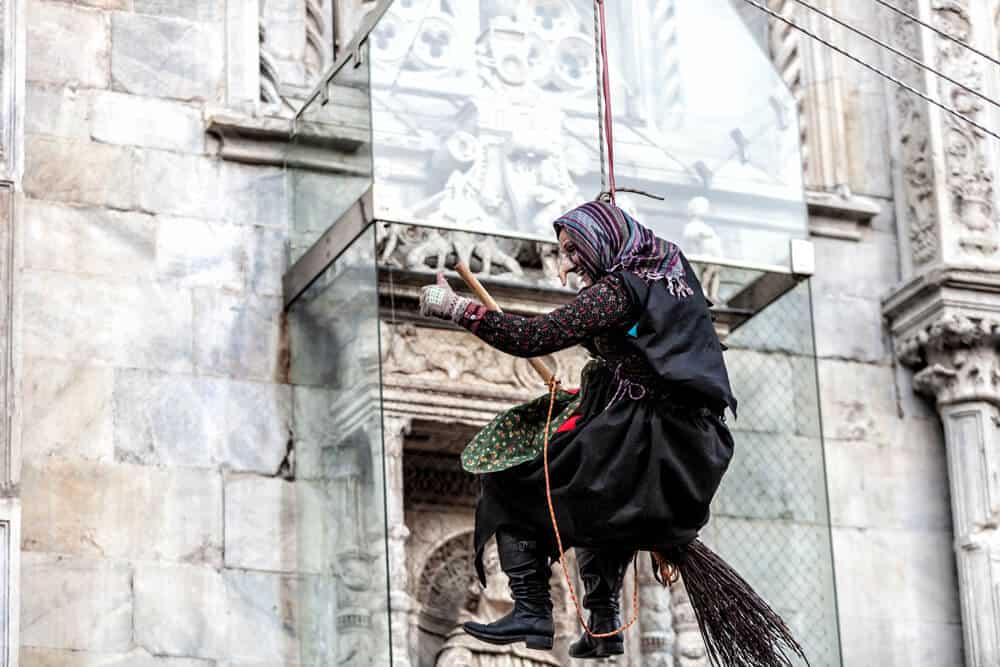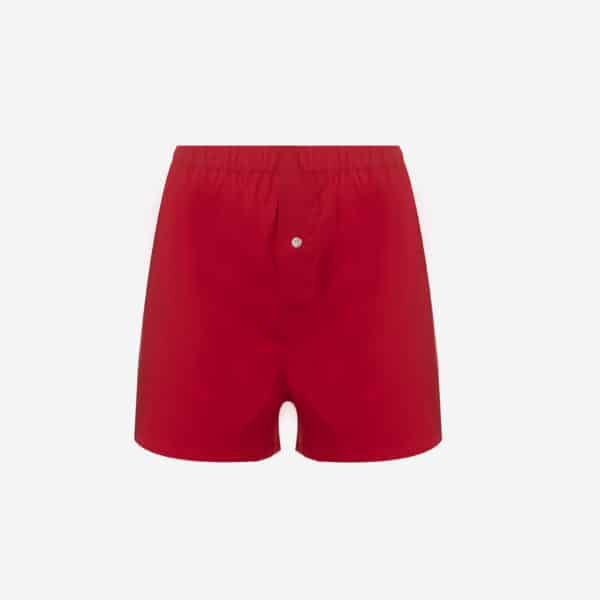How Italy Celebrates the Winter Holidays
Walk down any town street in Italy during late autumn, you’ll find The Christmas Song come to life where a caldarostaio is open-roasting castagne (chestnuts) on the street corner and in just a few weeks, streets light up with holiday decorations. Babbo Natale, panettone and la Befana are coming to town.
Le tradizioni natalizie (Christmas traditions) officially kick off on December 8 with the Festa dell’Immacolata, a national holiday commemorating the Immaculate Conception and a special celebration in Rome where the Pope parades through the city to bless a crown atop a statue of the Virgin Mary in a square next to Piazza di Spagna. Truth be told, Italy has been pregraming the holiday season since late November. By the end of the month, decorations begin appearing on store fronts and on December 6, children wake up to receive fruits, nuts and sweets celebrating San Nicolò di Bari, Saint Nicholas, patron Saint of Bari. Think of Saint Nick as an amuse bouche to Father Christmas’s end of December appearance.
Festivities and decorations across Italy
December is merry and bright. Festive adobbi – artful illumination, wreathes and more – decorate cities, towns and homes. Christmas tree lighting ceremonies illuminate piazzas around the country including San Pietro at the Vatican, Piazza Venezia in Rome and Milano’s Piazza Duomo. Charming holiday markets pop up in piazze, especially in Trentino – Alto Adige region, as well as larger cities like Venezia, Bologna, Firenze and Roma, where delicious local delights and artisanal gifts can be found amongst the many stalls.

Traditions at Home
At home, one of the most beloved traditions is the presepe, the beautiful Christmas nativity scene, often handcrafted by artisans from Napoli, the city known worldwide as Presepe central. (In fact, Entire strade in the Spaccanapoli like Via San Gregorio Armeno are filled with handcrafted presepi and workshops devoted to the craft.) An artisanal holiday tradition, the presepe is a miniature celebration of Christmas Eve, and traditionally includes a crib filled with straw, baby Jesus, Mary and Joseph.
Every presepe is different and personalized with figurines like Benino, the sleeping shepherd who dreamt of the birth of Jesus, the Re Magi (three kings) bearing gifts of gold, frankincense and myrrh, shepherds, angels, sheep, camels and animals and many even add their own “religious” idols with (humorous) mini lucky statues of Totti, Obama, Maradona and other celebrities popping up in presepi here and there. Outside of the home, miniature, life-size and larger than life presepi appear on side streets, town squares and church chapels.
On December 13, some Northern Italian cities celebrate Saint Lucia with children receiving gifts – yet another pre-Babbo Natale antipasto. During the eight days before Christmas, known as the Novena, carollers sing traditional holiday songs and the zampognari, bagpipe players, travel to Rome, southern Italy and Sicily from nearby mountain towns to play holiday folk songs. In Trentino- Alto Adige, Corona dell’Avvento, an Advent wreath of pine branches and silk ribbon, decorated with four candles, are lit for each Sunday leading up to Christmas. In Lucca, Tuscany, large bonfires welcome and warm up the festive season.
Christmas Eve and Christmas Day feasts
December 24 is la Vigilia di Natale, Christmas eve, celebrated with family and delicious fish-focused banquet like la Festa dei Sette Pesci (a meal focusing on multiple fish courses). Some families head out to mass – in Rome, evening masses at Santa Maria in Aracoeli, San Pietro and Santa Maria Maggiore are cherished, while most families prefer to stay in playing cards and tombola (bingo-like prize winning game often) well into the wee hours.
In Cortina d’Ampezzo in the Dolomites, skiers welcome in the first hours of Christmas Day in a torch lit run. In the medieval village of Faglia di Oratino in Molise, residents build a large candle made of dry branches, measuring 15 meters high, and carry it to the town’s main church to be burned on Christmas Eve. The townspeople gather round on Christmas morning to collect the remaining ashes as keepsakes for good fortune and happiness in the New Year. And of course, Babbo Natale (Santa Claus), makes his very first appearance on Christmas Eve with presents often displayed on a pyramid-shaped ceppo, together with candles and other decorations.
Christmas Day is reserved for the Pranzo di Natale, a lavish celebration which features beloved dishes like tortellini in brodo in Emilia Romagna, polenta with boiled baccalà in sauce in the Veneto region, eel baked in foil in Lombardy, boiled lamb seasoned with sauce in Piemonte, chicken livers and roast guinea fowl or stuffed capon in Tuscany, spaghetti alle vongole (spaghetti with clams) or capon broth to start followed by stuffed capon in Campania, Sardegna’s delicious tiny gnocchi known as malloreddus, or hen broth and pasta con le sarde (pasta with sardines) in Sicily. Romans celebrate with a grande mix of fritto (fried foods) which includes broccoli, artichokes, zucchini as well as bread with ricotta and the not-to-be missed second fish dishes. A festive Christmas roast usually makes a highlight on any table as well.

Regional holiday treats
Each region has it’s Dolce Christmas staples including panettone, pandoro and panforte, Italy’s version of fruitcake, along with the nutty and nougaty torrone e panpeppato. Depending on the region, there are a myriad of dolci to enjoy including parrozzo in Abruzzo, pandolce from Genova, panone in Bologna, struffoli, roccocò and susamielli in Napoli, tozzetti biscotti-like sweets from the Lazio town of Viterbo, and Puglia’s famous mostaccioli cookies. Celebrations extend into the night, playing raucous games of tombola. On Santo Stefano, December 26, (Boxing Day), families gather together once again to enjoy leftover dishes and sweets.
But it’s not over yet! New Year’s Eve, also known as San Silvestro in Italy, is a day to rid your home of old, used items as a sign to the universe you’re ready to ring in the newand to call on your luck by donning your sexiest red intimates. Red is the colour to ring in the New Year, and represents prosperity, vitality and love while warding off bad spirits. Our tradition is simple: give a gift of mutande rosse (red boxers and bikinis) to wear on New Year’s Eve and then throw them out, and you’re guaranteed a year full of love and prosperity.
It’s important to bring in the New Year with good fortune and good food. Make sure to eat the auspicious traditional dish of lenticchie e cotechino (lentils with sausage), followed by a lucky melograno (pomegranate) and light up a few sparklers to get rid of evil spirits. A glass of champagne to brindare (toast) is a must and some say beer brings even better luck, while others advise eating a carrot or even a bunch of grapes to welcome in good fortune.
At midnight, close your eyes, cross your fingers and make three wishes – legend has it they’ll all come true in the New Year. If you’re with your beloved, a kiss under the mistletoe at midnight cannot be missed. For those ladies who are single, take a candle and look into a mirror, your beloved just might appear. For those who are looking to make it to the altar, some say if you throw your slippers behind you at midnight, he’ll put a ring on it in the New Year.

Ending the holidays with a witch
La Befana, Italy’s answer to Mr. Scrooge, arrives on January 6th, marking the Epiphany. According to the story, an ancient witch flies around the countryside searching homes for the Christ child and stuffing sweet treats and presents into the stockings of good children. Those who were naughty get carbone (a lump of coal) usually in the form of black sugar sweets, while nice ones get small toys. Once La Befana arrives, the holidays are officially ending and time to start the New Year. Happy 2021!
-
 ISSIMO X Schostal Red Boxer Shorts35,00€ Incl. VAT
ISSIMO X Schostal Red Boxer Shorts35,00€ Incl. VAT
